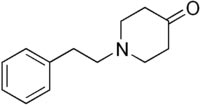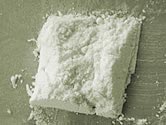|
HOME >>
Chemicals
>>
Chemicals List 1 >> N-Phenethyl-4-piperidinone
N-Phenethyl-4-piperidinone
CAS number 39742-60-4
 
N-Phenethyl-4-piperidinone IUPAC name
1-(2-Phenylethyl)piperidin-4-one
Other names N-Phenethyl-4-piperidinone
Abbreviations NPP
Identifiers
CAS number [39742-60-4]
SMILES
C1CN(CCC1=O)CCC2=CC=CC=C2
Properties
Molecular formula C13H17NO
Molar mass 203.28 g mol−1
Hazards
EU classification Flammable (F)
Harmful (Xn)
Dangerous for
the environment (N)
N-Phenethyl-4-piperidinone (NPP) is a derivative of 4-piperidinone
with the molecular formula C13H17NO. 4-Piperidone is used as an
intermediate in the manufacture of chemicals and pharmaceutical
drugs such as fentanyl.
Because of its use in the illicit manufacture of fentanyl, NPP was
placed onto the list of controlled chemicals in the USA in 2007, and
possession and sales of this compound are now heavily restricted.
Chemistry
Synthesis:
* 4-piperidinone hydrochloride was first reacted with phenethyl
bromide to give N-phenethyl-4-piperidinone (NPP).
* Treatment of the NPP intermediate with aniline.
* Reduction with sodium borohydride afforded
4-anilino-N-phenethyl-piperidine (ANPP).
* A final acylation reaction between ANPP and propionic anhydride
led to the fentanyl.
Analogues: Alfentanil
* Opioid analgesic (painkiller) with rapid onset of action
* Used for surgery
* Injectable alfentanil marketed under brand name Alfenta
* Can last around 30 minutes
Carfentanil
* Marked under the name Wildnil as a tranquilizer for large animals
* 10,000 times stronger than morphine
* 100 times stronger than fentanyl
* Discovered by Janssen Pharmaceutica
Remifentanil
* Opioid analgesic (painkiller) marked under the name Ultiva
* Extremely rapid onset and offset
* Blood concentration decreases by 50% in 3-6 minutes after a
one-minute infusion of remifentanil
Sufentanil
* 5-10 times more potent than fentanyl
* Marketed as Sufenta and Sufentil
* Sometimes used during anesthesia
* Transdermal patch for chronic pain sufferers currently in
development
A narcotic analgesic used in combination with other drugs before,
during, or following surgery and also for chronic pain management.
| |
|
Note /Government
Notification: These chemicals are designated as those that are
used in the manufacture of the controlled substances and are
important to the manufacture of the substances. For any (Control
Substance) products Import and Export *** subjected to your
country government laws /control substance ACT.
Information: The information on this web page is provided to
help you to work safely, but it is intended to be an overview of
hazards, not a replacement for a full Material Safety Data Sheet
(MSDS). MSDS forms can be downloaded from the web sites of many
chemical suppliers. ,also that the information on the PTCL
Safety web site, where this page was hosted, has been copied
onto many other sites, often without permission. If you have any
doubts about the veracity of the information that you are
viewing, or have any queries, please check the URL that your web
browser displays for this page. If the URL begins "www.tajapi.com/www/Denatonium
Benzoate.htm/" the page is maintained by the Safety Officer in
Physical Chemistry at Oxford University. If not, this page is a
copy made by some other person and we have no responsibility for
it.
The Controlled Substances Act (CSA) was enacted into law by the
Congress of the United States as Title II of the Comprehensive
Drug Abuse Prevention and Control Act of 1970.[1] The CSA is the
federal U.S. drug policy under which the manufacture,
importation, possession, use and distribution of certain
substances is regulated. The Act also served as the national
implementing legislation for the Single Convention on Narcotic
Drugs |
|
|
 |



